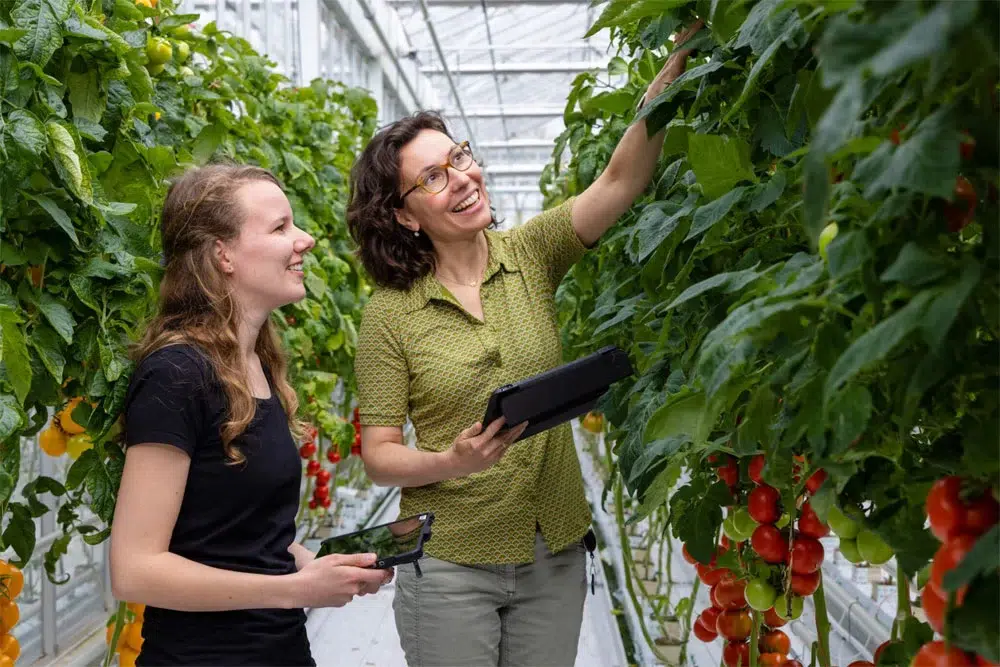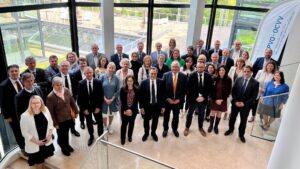An outlook on the future of variety inspection and testing in Europe.
Why it Matters
With the new proposed EU legislation on Plant Reproductive Material now public, European Seed checked in with John van Ruiten, managing director of the Netherlands’ Quality and Inspection Service in Horticulture, Naktuinbouw. Van Ruiten has a long history in seed quality systems, and we wanted to get his opinion on various topics and developments in plant health as well as the new proposed EU legislation and its impact on the seed sector. Van Ruiten is now in his last year as managing director of Naktuinbouw. In 2024, he will retire after 23 years of leading the Dutch system for seed inspection.
European Seed (ES): John, you studied plant breeding and horticulture at Wageningen University, but you never entered the business as breeder or researcher. How come?
John van Ruiten (JvR): I started my professional career in 1985 when I joined the NAKS, an inspection organisation in ornamentals in the Netherlands, as technical director. In that period, the ornamental propagating and breeding sector grew very rapidly. My focuses were internationalisation, new propagation techniques, certification, and at the end of the 1980’s, new EU legislation on propagating material of ornamental species. I enjoyed working in a part of the horticultural sector, building good quality and testing systems in very close cooperation with breeders and cutting producers. In 1993 this service merged with NAKB, which existed for the certification of fruit plants and arboriculture, and later with NAKG, which carried out inspections within the vegetable crop sector, to in 2000 form Naktuinbouw.
So, although I am not a plant breeder myself, I have always worked in the breeding sector. And having that education and technical knowledge helped me a lot in understanding the issues and challenges companies face.
ES: Internationally speaking, Naktuinbouw has a special position as an official organisation, executing government tasks, but separate from government. Explain.
JvR: Yes, this is what we call a specific Dutch construction. The reason goes back almost 100 years, when seed producers and organisations in our country felt the need to create their own private system to control the quality of seeds and plant material. At that time, there was a lot of inferior material in the market, which was not only bad for the buyers of that material, but also damaging for the trust of other producers and the image of the sector. So, in the Netherlands (NL), a number of private, non-profit foundations were created by growers that were tasked to safeguard identity, quality and health of seeds and plant material. For a long time, this was voluntary, but with the creation of the Seeds and Planting Material Act in NL in 1966, the government decided to make use of this existing system and gave it an official status. From that moment onwards, growers were legally obliged to be registered and to have their material inspected and tested. Based on a long history and commitment of the companies in the sector, this led to the current situation that in NL we have inspection systems that were developed in very close cooperation with the sector itself.
ES: If this system is operated by a non-governmental organisation, does it maintain independence?
JvR: Of course, this is an important issue. All inspection organisations in NL (also in agricultural field crops NAK and flower bulbs BKD) have a board with representatives from the sector, and a chairperson of the board appointed by the Ministry of Agriculture Nature and Food Quality. Each board holds responsibility for financing activities, investments, tariffs, rules and regulations and organisational developments. Decisions of each board need the approval of the minister, but the actual execution of all operational work fully occurs under the responsibility of the management, without any interference of the board. Both the National Plant Protection Organization (NPPO/NVWA) and the Ministry of Agriculture supervise the work. And in the last 15 years official accreditation (ISO 17020, 17025 and ISO 9001), also safeguarded our unbiased and independent operation. Also, our registered growers (approximately 3,000 operators are active in NL in production and trade of horticultural seeds and plants) require and receive professional, objective, and good quality work from our inspectors, laboratories, and variety testing.
ES: Plant health has become an increasingly important issue. It can be extremely complicated for internationally operating seed companies to fulfil requirements for so many countries. What is your feeling about this?
JvR: Plant health issues are nowadays both the backbone and Achilles heel of seed production and trade. With new diseases emerging continuously and old diseases coming back, with increasingly ultrasensitive test techniques and with increasing demands from buyers of the material, I expect that plant health topics will be top-of-mind for seed companies’ management for the next decade. Buyers want disease-free seeds, especially as the possibilities for (chemical) disease control decrease. It is in their own interest that seed companies develop strong varieties and healthy seeds. We have seen that claims related to disease infections possibly caused by infected seeds can be gigantic and can ruin the good name of both a variety and a seed company.
ES: And how about all these phytosanitary checks and requirements at the border? And even more political trade barriers?
JvR: Market access in a global environment requires very serious management of healthy seed production. Increasing barriers (regardless of what type) for moving seeds around the globe can only be overcome by providing adequate guarantees that production, field inspection and testing ensure that seeds are reliable and disease free. Choosing good locations for seed production, managing hygiene, carrying out continuous checks for diseases and taking quick and adequate measures are necessary. And before further processing and marketing: testing and more testing. In my opinion, the testing should as much as possible be done under the responsibility of companies themselves, supported by official monitoring, supervision, and control if necessary. I have always been a promotor of a systems approach for safeguarding plant health. I am very proud that colleagues and specialists in my service developed, in close cooperation with the seed companies in ISHI Veg good protocols and good system approaches like NAL, NAFI, ELITE, GSPP, SELECT PLANT and other systems to assist companies to step into that development. Participation in our Naktuinbouw programs is possible for companies around the globe.
ES: You mentioned new testing techniques. I have heard these are so sensitive that one may question if a disease infection is really found when a so-called positive test occurs.
JVR: That really is an important and headache-causing issue. On the one hand, we are pleased that we have such good, rapid and sensitive techniques. With PCR and now also Next Generation Sequencing (NGS), we are able to find extremely low amounts of pathogens. But indeed, the point of “what if you find a positive in a sample and can it lead to disease problems?” is a fundamental question. Is it “dead or alive”, is it environmental DNA that we find, is it pathogenic or not: these are all very fundamental issues. And with the use of these techniques by more and more inspection agencies, we have to find better answers, otherwise the sector and seed trade will run into big problems. Some people have already called it “Russian roulette” and I can imagine what they mean. I would like to see cooperative international projects to address this issue of “biological relevance”, funded by both the seed sector and governments.
ES: Naktuinbouw does more than inspections. You are one of the leading Examination Offices in the EU for variety testing. Which developments do you see?
JVR: Annually, my colleagues in our variety testing department test over 2,000 new varieties in order to grant plant breeders’ rights and allow varieties to be listed in EU official variety lists. Important crops for us are vegetables, ornamentals, seed potatoes (including true potato seeds) and grasses. We work for the CPVO and the Netherlands Board for Plant Varieties and are working closely together with our EU colleague EO’s, like GEVES and BSA, to develop DUS test methods. Most of our work is still morphological and relating to biological disease resistance checks. If I look at the future, my expectation is that we will — and have to — enter more and more into the world of testing the variety capacity for nutrient content, active compounds, and stress tolerances. I think that testing characteristics of new varieties with DNA or biomolecular techniques must be rapidly developed further. Naktuinbouw is at the forefront of these innovations in variety testing and that is a good thing. Introduction of new traits and rapid, reliable, and objective testing procedures are very necessary. This might also lead to better possibilities for global DUS testing of new varieties for global protection in the future, in which growing of new varieties in all these UPOV countries and different circumstances might be less needed.
ES: And how do you look at the use of new breeding techniques (NBT) for variety development?
JvR: I am very pleased that the EU Commission has recently made a proposal to look differently at new varieties created with specific molecular adjustment techniques like CRISPR-CAS and not regard them as genetically modified. I hope that a proper procedure for allowing these varieties to be marketed will be achieved in a couple of years. I believe it will help our agricultural sector and society to create better varieties in a much shorter timespan than would be possible with only classic breeding techniques and marker assisted breeding. Also, in fruit species and other crops with a long generation duration, it can enormously bring down the timeframe needed to create more sustainable varieties.
But it will also create new challenges and questions: how to deal with essential derivation, what is the minimum distance needed to distinguish varieties, how to identify the use of these techniques? And what we see more and more is the patenting of genes and traits, which I personally do not find a desirable road. The breeders’ exemption that allows the use of all existing material/varieties for the creation of new varieties has brought the horticultural sector very far and makes it possible for a very broad range of plant breeders to create better varieties.
ES: The introduction of Sustainable VCU is one of the cornerstones of the recent EU PRM Regulation proposal. Do you think that it is desirable to have these requirements for sustainability in legislation?
JvR: I do understand the proposal of the EU Commission. It is, in my opinion, absolutely necessary that in agricultural policies and regulations the choice is made to support development of more sustainable production systems, and that conservation of biodiversity is a key issue. Of course, one can have different ideas on the importance of specific elements, but overall, it is a very logical thought that genetics play an important role. Therefore, new varieties or older varieties with proper characteristics can be crucial for the required change or path to more sustainable horticulture.
Of course, breeders are already working on the varieties of tomorrow. Most likely, they do not even need legislation to continue with that. But I see the possibility to also make the quality of those newly created varieties visible, for farmers and for society. This will underline that breeders and companies are doing the right thing with the use of modern, environmentally friendly and safe techniques. So, we should see it as a challenge and not a threat.
ES: But how about all additional costs and time needed?
JvR: Good point. In my opinion, this is an important issue to overcome. How can we use information that is already available at the breeders’ premises, and how can we use information becoming available in the period of variety introduction (phase of premarketing permission)? Which tests can be carried out under official supervision? As the demand for new, resistant, and better varieties is great, we need to develop rapid, robust, reliable, and affordable methods of examination.
The same is true for certification programs: the presented option for making operators responsible for certification themselves under official supervision is interesting, on the condition that this system is also applicable for inspection and testing according to plant health regulation requirements. Naktuinbouw and its registered companies have already been using this kind of systems for several years, with good experience.
There is still a lot of work to do, but for our beautiful and strong seed sector I am sure this challenge can be brought to a good end so we can continue towards our common goal: to feed the people and to save the planet.













